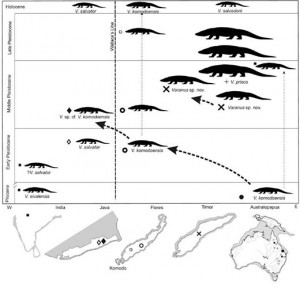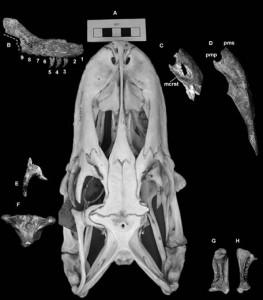The Origin of the Komodo Dragon
/https://tf-cmsv2-smithsonianmag-media.s3.amazonaws.com/filer/20110520102255komodo-evolution-520-300x284.jpg)

The world's largest living lizard is the Komodo dragon (Varanus komodoensis), a type of "varanid" lizard. Despite the fact that Komodo dragons are very interesting and widely known, there is a lot missing in our understanding of their natural history. Now a study of fossil evidence from Australia, Timor, Flores, Java and India shows that Komodo Dragons most likely evolved in Australia and dispersed westward to Indonesia. Some of the fossils that have been studied are newly described, including a species from Timor, and some are material known for a long time.
Here's the most important finding: The two main hypotheses for the origin of the Komodo dragon have been brought into question and replaced with a new and better hypothesis.
It was previously thought that one of the best explanations for the large size of the Komodo dragon was the "island effect." On islands, some animals may get bigger because of an increasing reliance on lower quality food found on island—the larger body size accommodates a gut that can process the food. In other cases, animals get smaller for a variety of reasons. But mostly, islands have strange effects on many species because evolution in the small population can proceed very rapidly. The animals that are confined to islands for long periods of time may simply evolve into food niches (which often relate to body size) that their sister species on the mainland did not experience.
A second hypothesis for the large size of Komodo dragons is that they were once specialists in the hunting of the pygmy Stegodon (a small elephant). This is a sort of indirect island effect. The Stegodons got small because they lived on islands, and the lizards evolved to be large enough to eat them.
Both of these hypotheses—island effects and specialist Stegodon hunter—now seem unlikely. The new research

indicates that Komodo dragons were really part of a distribution of related species of really large lizards across the region, including Australia. In fact, in comparison to some of these other lizards, Komodo dragons are kind of small.
In the words of Scott Hocknull, Senior Curator of Geosciences at the Queensland Museum and author of the paper, Australia is a hub for lizard evolution:
The fossil record shows that over the last four million years Australia has been home to the world's largest lizards, including a five meter giant called Megalania (Varanus prisca). Now we can say Australia was also the birthplace of the three-meter Komodo dragon (Varanus komodoensis), dispelling the long-held scientific hypothesis that it evolved from a smaller ancestor in isolation on the Indonesian islands. Over the past three years, we've unearthed numerous fossils from eastern Australia dated from 300,000 years ago to approximately four million years ago that we now know to be the Komodo dragon. When we compared these fossils to the bones of present-day Komodo dragons, they were identical. This research also confirms that both giant lizards, Megalania (Varanus priscus) and the Komodo dragon (Varanus komodoensis), existed in Australia at the same time.
This research was published Tuesday in the Open Access journal PLoS ONE. You can access this paper here.
Citation: Hocknull SA, Piper PJ, van den Bergh GD, Due RA, Morwood MJ, et al. (2009) Dragon’s Paradise Lost: Palaeobiogeography, Evolution and Extinction of the Largest-Ever Terrestrial Lizards (Varanidae). PLoS ONE 4(9): e7241. doi:10.1371/journal.pone.0007241
Greg Laden is guest-blogging this week while Sarah is on vacation. You can find his regular blog at Scienceblogs.com and Quiche Moraine.
The world's largest living lizard is the Komodo dragon (Varanus komodoensis), a type of "varanid" lizard. Despite the fact that Komodo dragons are very interesting and widely known, there is a lot missing in our understanding of their natural history. Now a study of fossil evidence from Australia, Timor, Flores, Java and India shows that Komodo Dragons most likely evolved in Australia and dispersed westward to Indonesia. Some of the fossils that have been studied are newly described, including a species from Timor, and some are material known for a long time.
Here's the most important finding: The two main hypotheses for the origin of the Komodo dragon have been brought into question and replaced with a new and better hypothesis.
It was previously thought that one of the best explanations for the large size of the Komodo dragon was the "island effect." On islands, some animals may get bigger because of an increasing reliance on lower quality food found on island—the larger body size accommodates a gut that can process the food. In other cases, animals get smaller for a variety of reasons. But mostly, islands have strange effects on many species because evolution in the small population can proceed very rapidly. The animals that are confined to islands for long periods of time may simply evolve into food niches (which often relate to body size) that their sister species on the mainland did not experience.
A second hypothesis for the large size of Komodo dragons is that they were once specialists in the hunting of the pygmy Stegodon (a small elephant). This is a sort of indirect island effect. The Stegodons got small because they lived on islands, and the lizards evolved to be large enough to eat them.
Both of these hypotheses—island effects and specialist Stegodon hunter—now seem unlikely.

The new research indicates that Komodo dragons were really part of a distribution of related species of really large lizards across the region, including Australia. In fact, in comparison to some of these other lizards, Komodo dragons are kind of small.
In the words of Scott Hocknull, Senior Curator of Geosciences at the Queensland Museum and author of the paper, Australia is a hub for lizard evolution:
The fossil record shows that over the last four million years Australia has been home to the world's largest lizards, including a five meter giant called Megalania (Varanus prisca). Now we can say Australia was also the birthplace of the three-meter Komodo dragon (Varanus komodoensis), dispelling the long-held scientific hypothesis that it evolved from a smaller ancestor in isolation on the Indonesian islands. Over the past three years, we've unearthed numerous fossils from eastern Australia dated from 300,000 years ago to approximately four million years ago that we now know to be the Komodo dragon. When we compared these fossils to the bones of present-day Komodo dragons, they were identical. This research also confirms that both giant lizards, Megalania (Varanus priscus) and the Komodo dragon (Varanus komodoensis), existed in Australia at the same time.
This research was published Tuesday in the Open Access journal PLoS ONE. You can access this paper here.
Citation: Hocknull SA, Piper PJ, van den Bergh GD, Due RA, Morwood MJ, et al. (2009) Dragon’s Paradise Lost: Palaeobiogeography, Evolution and Extinction of the Largest-Ever Terrestrial Lizards (Varanidae). PLoS ONE 4(9): e7241. doi:10.1371/journal.pone.0007241
/https://tf-cmsv2-smithsonianmag-media.s3.amazonaws.com/accounts/headshot/greg-laden-240.jpg)
/https://tf-cmsv2-smithsonianmag-media.s3.amazonaws.com/accounts/headshot/greg-laden-240.jpg)